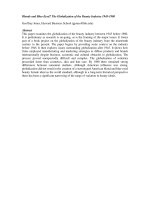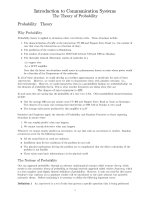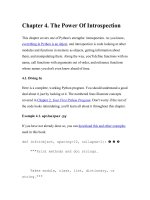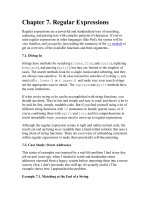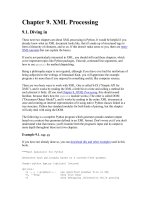Tài liệu Dive Into Python-Chapter 4. The Power Of Introspection ppt
Bạn đang xem bản rút gọn của tài liệu. Xem và tải ngay bản đầy đủ của tài liệu tại đây (528.09 KB, 45 trang )
Chapter 4. The Power Of Introspection
This chapter covers one of Python's strengths: introspection. As you know,
everything in Python is an object, and introspection is code looking at other
modules and functions in memory as objects, getting information about
them, and manipulating them. Along the way, you'll define functions with no
name, call functions with arguments out of order, and reference functions
whose names you don't even know ahead of time.
4.1. Diving In
Here is a complete, working Python program. You should understand a good
deal about it just by looking at it. The numbered lines illustrate concepts
covered in Chapter 2, Your First Python Program. Don't worry if the rest of
the code looks intimidating; you'll learn all about it throughout this chapter.
Example 4.1. apihelper.py
If you have not already done so, you can download this and other examples
used in this book.
def info(object, spacing=10, collapse=1):
"""Print methods and doc strings.
Takes module, class, list, dictionary, or
string."""
methodList = [method for method in dir(object)
if callable(getattr(object, method))]
processFunc = collapse and (lambda s: "
".join(s.split())) or (lambda s: s)
print "\n".join(["%s %s" %
(method.ljust(spacing),
processFunc(str(getattr(object, method).__doc__)))
for method in methodList])
if __name__ == "__main__":
print info.__doc__
This module has one function, info. According to its function
declaration, it takes three parameters: object, spacing, and
collapse. The last two are actually optional parameters, as you'll see
shortly.
The info function has a multi-line doc string that succinctly
describes the function's purpose. Note that no return value is mentioned;
this function will be used solely for its effects, rather than its value.
Code within the function is indented.
The if __name__ trick allows this program do something useful when
run by itself, without interfering with its use as a module for other
programs. In this case, the program simply prints out the doc string of
the info function.
if statements use == for comparison, and parentheses are not required.
The info function is designed to be used by you, the programmer, while
working in the Python IDE. It takes any object that has functions or methods
(like a module, which has functions, or a list, which has methods) and prints
out the functions and their doc strings.
Example 4.2. Sample Usage of apihelper.py
>>> from apihelper import info
>>> li = []
>>> info(li)
append L.append(object) -- append object to end
count L.count(value) -> integer -- return
number of occurrences of value
extend L.extend(list) -- extend list by
appending list elements
index L.index(value) -> integer -- return
index of first occurrence of value
insert L.insert(index, object) -- insert object
before index
pop L.pop([index]) -> item -- remove and
return item at index (default last)
remove L.remove(value) -- remove first
occurrence of value
reverse L.reverse() -- reverse *IN PLACE*
sort L.sort([cmpfunc]) -- sort *IN PLACE*; if
given, cmpfunc(x, y) -> -1, 0, 1
By default the output is formatted to be easy to read. Multi-line doc
strings are collapsed into a single long line, but this option can be
changed by specifying 0 for the collapse argument. If the function names
are longer than 10 characters, you can specify a larger value for the
spacing argument to make the output easier to read.
Example 4.3. Advanced Usage of apihelper.py
>>> import odbchelper
>>> info(odbchelper)
buildConnectionString Build a connection string
from a dictionary Returns string.
>>> info(odbchelper, 30)
buildConnectionString Build a connection
string from a dictionary Returns string.
>>> info(odbchelper, 30, 0)
buildConnectionString Build a connection
string from a dictionary
Returns string.
4.2. Using Optional and Named Arguments
Python allows function arguments to have default values; if the function is
called without the argument, the argument gets its default value. Futhermore,
arguments can be specified in any order by using named arguments. Stored
procedures in SQL Server Transact/SQL can do this, so if you're a SQL
Server scripting guru, you can skim this part.
Here is an example of info, a function with two optional arguments:
def info(object, spacing=10, collapse=1):
spacing and collapse are optional, because they have default values
defined. object is required, because it has no default value. If info is
called with only one argument, spacing defaults to 10 and collapse
defaults to 1. If info is called with two arguments, collapse still
defaults to 1.
Say you want to specify a value for collapse but want to accept the
default value for spacing. In most languages, you would be out of luck,
because you would need to call the function with three arguments. But in
Python, arguments can be specified by name, in any order.
Example 4.4. Valid Calls of info
info(odbchelper)
info(odbchelper, 12)
info(odbchelper, collapse=0)
info(spacing=15, object=odbchelper)
With only one argument, spacing gets its default value of 10 and
collapse gets its default value of 1.
With two arguments, collapse gets its default value of 1.
Here you are naming the collapse argument explicitly and specifying
its value. spacing still gets its default value of 10.
Even required arguments (like object, which has no default value) can
be named, and named arguments can appear in any order.
This looks totally whacked until you realize that arguments are simply a
dictionary. The “normal” method of calling functions without argument
names is actually just a shorthand where Python matches up the values with
the argument names in the order they're specified in the function declaration.
And most of the time, you'll call functions the “normal” way, but you always
have the additional flexibility if you need it.
The only thing you need to do to call a function is specify a value
(somehow) for each required argument; the manner and order in which
you do that is up to you.
Further Reading on Optional Arguments
Python Tutorial discusses exactly when and how default arguments
are evaluated, which matters when the default value is a list or an
expression with side effects.
4.3. Using type, str, dir, and Other Built-In Functions
Python has a small set of extremely useful built-in functions. All other
functions are partitioned off into modules. This was actually a conscious
design decision, to keep the core language from getting bloated like other
scripting languages (cough cough, Visual Basic).
4.3.1. The type Function
The type function returns the datatype of any arbitrary object. The possible
types are listed in the types module. This is useful for helper functions that
can handle several types of data.
Example 4.5. Introducing type
>>> type(1)
<type 'int'>
>>> li = []
>>> type(li)
<type 'list'>
>>> import odbchelper
>>> type(odbchelper)
<type 'module'>
>>> import types
>>> type(odbchelper) == types.ModuleType
True
type takes anything -- and I mean anything -- and returns its datatype.
Integers, strings, lists, dictionaries, tuples, functions, classes, modules,
even types are acceptable.
type can take a variable and return its datatype.
type also works on modules.
You can use the constants in the types module to compare types of
objects. This is what the info function does, as you'll see shortly.
4.3.2. The str Function
The str coerces data into a string. Every datatype can be coerced into a
string.
Example 4.6. Introducing str
>>> str(1)
'1'
>>> horsemen = ['war', 'pestilence', 'famine']
>>> horsemen
['war', 'pestilence', 'famine']
>>> horsemen.append('Powerbuilder')
>>> str(horsemen)
"['war', 'pestilence', 'famine', 'Powerbuilder']"
>>> str(odbchelper)
"<module 'odbchelper' from
'c:\\docbook\\dip\\py\\odbchelper.py'>"
>>> str(None)
'None'
For simple datatypes like integers, you would expect str to work,
because almost every language has a function to convert an integer to a
string.
However, str works on any object of any type. Here it works on a list
which you've constructed in bits and pieces.
str also works on modules. Note that the string representation of the
module includes the pathname of the module on disk, so yours will be
different.
A subtle but important behavior of str is that it works on None, the
Python null value. It returns the string 'None'. You'll use this to your
advantage in the info function, as you'll see shortly.
At the heart of the info function is the powerful dir function. dir returns
a list of the attributes and methods of any object: modules, functions, strings,
lists, dictionaries... pretty much anything.
Example 4.7. Introducing dir
>>> li = []
>>> dir(li)
['append', 'count', 'extend', 'index', 'insert',
'pop', 'remove', 'reverse', 'sort']
>>> d = {}
>>> dir(d)
['clear', 'copy', 'get', 'has_key', 'items',
'keys', 'setdefault', 'update', 'values']
>>> import odbchelper
>>> dir(odbchelper)
['__builtins__', '__doc__', '__file__', '__name__',
'buildConnectionString']
li is a list, so dir(li) returns a list of all the methods of a list. Note
that the returned list contains the names of the methods as strings, not the
methods themselves.
d is a dictionary, so dir(d) returns a list of the names of dictionary
methods. At least one of these, keys, should look familiar.
This is where it really gets interesting. odbchelper is a module, so
dir(odbchelper) returns a list of all kinds of stuff defined in the
module, including built-in attributes, like __name__, __doc__, and
whatever other attributes and methods you define. In this case,
odbchelper has only one user-defined method, the
buildConnectionString function described in Chapter 2.
Finally, the callable function takes any object and returns True if the
object can be called, or False otherwise. Callable objects include
functions, class methods, even classes themselves. (More on classes in the
next chapter.)
Example 4.8. Introducing callable
>>> import string
>>> string.punctuation
'!"#$%&\'()*+,-./:;<=>?@[\\]^_`{|}~'
>>> string.join
<function join at 00C55A7C>
>>> callable(string.punctuation)
False
>>> callable(string.join)
True
>>> print string.join.__doc__
join(list [,sep]) -> string
Return a string composed of the words in list,
with
intervening occurrences of sep. The default
separator is a
single space.
(joinfields and join are synonymous)
The functions in the string module are deprecated (although many
people still use the join function), but the module contains a lot of useful
constants like this string.punctuation, which contains all the
standard punctuation characters.
string.join is a function that joins a list of strings.
string.punctuation is not callable; it is a string. (A string does
have callable methods, but the string itself is not callable.)
string.join is callable; it's a function that takes two arguments.
Any callable object may have a doc string. By using the callable
function on each of an object's attributes, you can determine which
attributes you care about (methods, functions, classes) and which you want
to ignore (constants and so on) without knowing anything about the object
ahead of time.
4.3.3. Built-In Functions
type, str, dir, and all the rest of Python's built-in functions are grouped
into a special module called __builtin__. (That's two underscores before
and after.) If it helps, you can think of Python automatically executing from
__builtin__ import * on startup, which imports all the “built-in”
functions into the namespace so you can use them directly.
The advantage of thinking like this is that you can access all the built-in
functions and attributes as a group by getting information about the
__builtin__ module. And guess what, Python has a function called
info. Try it yourself and skim through the list now. We'll dive into some of
the more important functions later. (Some of the built-in error classes, like
AttributeError, should already look familiar.)
Example 4.9. Built-in Attributes and Functions
>>> from apihelper import info
>>> import __builtin__
>>> info(__builtin__, 20)
ArithmeticError Base class for arithmetic
errors.
AssertionError Assertion failed.
AttributeError Attribute not found.
EOFError Read beyond end of file.
EnvironmentError Base class for I/O related
errors.
Exception Common base class for all
exceptions.
FloatingPointError Floating point operation
failed.
IOError I/O operation failed.
[...snip...]
Python comes with excellent reference manuals, which you should
peruse thoroughly to learn all the modules Python has to offer. But
unlike most languages, where you would find yourself referring back to
the manuals or man pages to remind yourself how to use these modules,
Python is largely self-documenting.
Further Reading on Built-In Functions
Python Library Reference documents all the built-in functions and all
the built-in exceptions.
4.4. Getting Object References With getattr
You already know that Python functions are objects. What you don't know is
that you can get a reference to a function without knowing its name until
run-time, by using the getattr function.
Example 4.10. Introducing getattr
>>> li = ["Larry", "Curly"]
>>> li.pop
<built-in method pop of list object at 010DF884>
>>> getattr(li, "pop")
<built-in method pop of list object at 010DF884>
>>> getattr(li, "append")("Moe")
>>> li
["Larry", "Curly", "Moe"]
>>> getattr({}, "clear")
<built-in method clear of dictionary object at
00F113D4>
>>> getattr((), "pop")
Traceback (innermost last):
File "<interactive input>", line 1, in ?
AttributeError: 'tuple' object has no attribute
'pop'
This gets a reference to the pop method of the list. Note that this is not
calling the pop method; that would be li.pop(). This is the method
itself.
This also returns a reference to the pop method, but this time, the method
name is specified as a string argument to the getattr function.
getattr is an incredibly useful built-in function that returns any
attribute of any object. In this case, the object is a list, and the attribute is
the pop method.
In case it hasn't sunk in just how incredibly useful this is, try this: the
return value of getattr is the method, which you can then call just as if
you had said li.append("Moe") directly. But you didn't call the
function directly; you specified the function name as a string instead.
getattr also works on dictionaries.
In theory, getattr would work on tuples, except that tuples have no
methods, so getattr will raise an exception no matter what attribute
name you give.
4.4.1. getattr with Modules
getattr isn't just for built-in datatypes. It also works on modules.
Example 4.11. The getattr Function in apihelper.py



